|
|
|
|
|
Galleria Tassonomica
di
Natura Mediterraneo
|
|
|
| Autore |
 Discussione Discussione  |
|
|
enrirubio
Utente V.I.P.
  
Città: Avilés
Regione: Spain

132 Messaggi
Micologia |
 Inserito il - 23 febbraio 2021 : 12:29:49 Inserito il - 23 febbraio 2021 : 12:29:49


Ordine: Agaricales Famiglia: Cyphellaceae Genere: Chondrostereum Specie:Chondrostereum purpureum
|
I am asking for your help in trying to know this corticioid fungus which was growing on Laburnum branches still attached to the tree.
The hymenyum is smooth or wavy because it adapts to the pyrenomycetes beneath it, waxy, and cracks deeply in old age. The margins are reflexed, almost pileate, and externally zonate and very hairy. KOH negative. Basidia long, terminal, with four smooth, ellipsoidal, spores that do not appear to be amyloid. Some more or less fusiform leptocystidia can be seen, up to 5-6 microns wide, exceeding the level of the hymenium.
The hyphal system is monomitic and the subiculum is abundant, white, with very dense and difficult to separate hyphae. Some of them are thick-walled and sometimes have inconstant clamps.There are also clavate cells between the cylindric hyphae of the subiculum.
It looks like a Phlebia, but is also reminiscent of a stereoid fungus by the reflexed margins of the basidiomata.
Do you have any ideas that could help me?
Many thanks again.
Chiedo il vostro aiuto per cercare di determinare questo fungo corticioide che stava crescendo sui rami di Laburnum ancora attaccati all'albero.
L'imenoforo è liscio o ondulato perché si adatta ai pirenomiceti sotto di esso, ceroso, e si incrina profondamente in età avanzata. I margini sono riflessi, quasi pileati, ed esternamente zonati e molto pelosi. KOH negativo. Basidi lunghi, terminali, con quattro spore lisce ed ellissoidali che non sembrano essere amiloidi. Si possono vedere alcuni leptocistidi più o meno fusiformi, larghi fino a 5-6 micron, che superano il livello dell'imenio.
Il sistema ifale è monomitico e il subiculum è abbondante, bianco, con ife molto dense e difficili da separare. Alcuni hanno pareti spesse e a volte hanno fibule inconsistenti.Ci sono anche cellule claviformi tra le ife cilindriche del subiculum.
Sembra una Phlebia, ma mi ricorda anche un fungo stereoide per il suo aspetto e i bordi riflessi del basidioma.
Avete qualche idea che possa aiutarmi?
Grazie molte
Immagine:
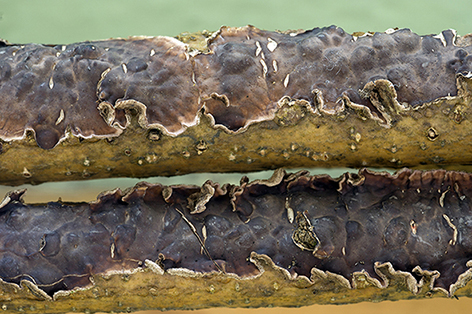
228,37 KB
Immagine:
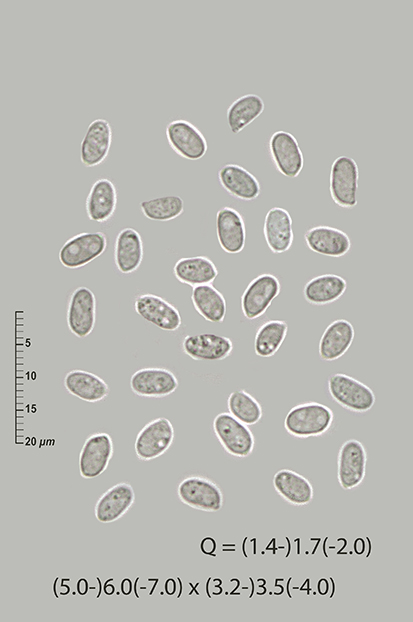
104,63 KB
Immagine:
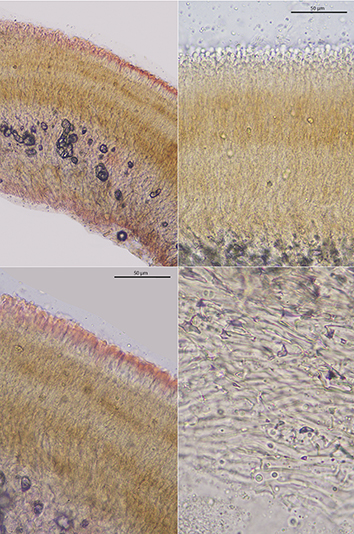
293,19 KB
Immagine:
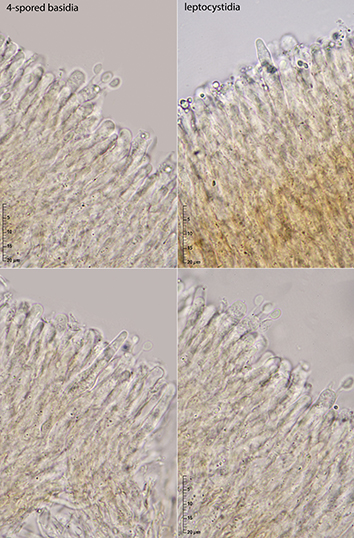
269,69 KB
Immagine:
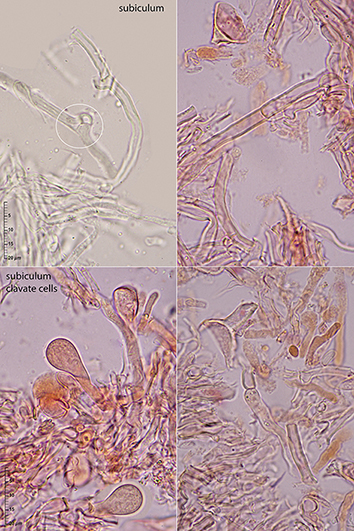
294,33 KB
|
Modificato da - Aphyllo in Data 02 aprile 2021 12:20:10
|
|
|
Aphyllo
Moderatore
    
Città: firenze
Prov.: Firenze
Regione: Toscana

9113 Messaggi
Micologia |
 Inserito il - 23 febbraio 2021 : 12:35:52 Inserito il - 23 febbraio 2021 : 12:35:52


|
| Sembrerebbe Chondrostereum purpureum ma le spore sono un po' larghe |
 |
|
|
enrirubio
Utente V.I.P.
  
Città: Avilés
Regione: Spain

132 Messaggi
Micologia |
 Inserito il - 23 febbraio 2021 : 13:00:11 Inserito il - 23 febbraio 2021 : 13:00:11


|
Ciao Aphyllo
Le mie spore sono un po' più larghe del solito, ma penso che ancora una volta tu abbia indovinato e che possa trattarsi di Chondrostereum purpureum.
Grazie mille ancora |
|
 |
|
| |
 Discussione Discussione  |
|
|
|
 Natura Mediterraneo Natura Mediterraneo |
© 2003-2024 Natura Mediterraneo |
 |
|
Leps.it | Herp.it | Lynkos.net
|

 Forum
|
Registrati
|
Msg attivi
|
Msg Recenti
|
Msg Pvt
|
Utenti
|
Galleria |
Map |
Forum
|
Registrati
|
Msg attivi
|
Msg Recenti
|
Msg Pvt
|
Utenti
|
Galleria |
Map |